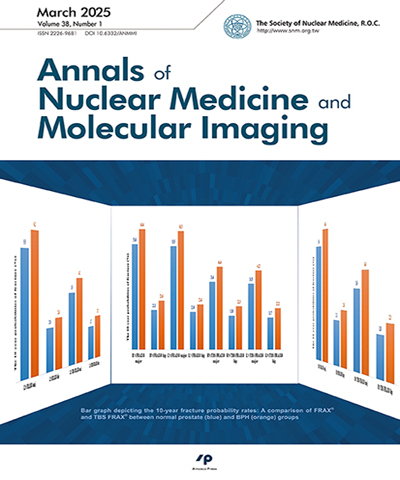
核子醫學暨分子影像雜誌/Annals of Nuclear Medicine and Molecular Imaging
中華民國核醫學學會 & Ainosco Press,正常發行
選擇卷期
- 期刊
Introduction: Conventional whole-body (WB) F-18 fluorodeoxyglucose positron emission tomography/ computed tomography (FDG-PET/CT) typically scans the area from the vertex to the upper thigh. Therefore, using conventional WB FDG-PET may fail to detect lesions outside the field of view, usually in bilateral lower extremities. However, with the advances of modern PET/ CT scanners, a “true” WB scan from the vertex to the feet can now be completed within 30 minutes, and this has become a standard practice of our institution. This retrospective study aims to evaluate the acquisition of additional findings in true WB FDG-PET/CT. Methods: The researchers of this study reviewed 3,310 consecutive FDG-PET/CT studies using true WB scan protocol from January 2010 to December 2016. Suspected malignant lesions in the lower extremities were verified through correlation with pathological results and clinical follow-up. Results: Eighty-five studies (2.6%) had additional findings in the lower extremities beyond what the conventional WB scan can cover. The primary diagnoses were lymphoma (30 of 267 studies, 11.2%), lung cancer (20 of 782 studies, 2.6%), melanoma with primary at lower extremities (8 of 11 studies, 72.7%), head and neck cancer (7 of 981 studies, 0.7%), colorectal cancer (4 of 490 studies, 0.8%), breast cancer (4 of 94 studies, 4.3%), esophageal cancer (2 of 262 studies, 0.8%), gastrointestinal stromal tumor (2 of 16 studies, 12.5%), soft tissue sarcoma (2 of 13 studies, 15.4%), malignant peripheral nerve sheath tumor (2 of 2 studies, 100%), urothelial cancer (1 of 7 studies, 14.3%), renal cell carcinoma (1 of 2 studies, 50%), Merkel cell carcinoma (1 of 1 study, 100%), and malignant pleural mesothelioma (1 of 1 study, 100%). Additional bone lesions were observed in 61 studies, soft tissue lesions in 11, and lymph node lesions in 13. Notably, a clinical stage was changed for only one patient due to the additional findings in the lower extremity. Conclusion: True WB scan resulted in additional findings in 2.6% of the studies, with more frequency observed in patients with lymphoma, melanoma from lower extremities, lung cancer, and breast cancer. This underscores the suitability of true WB FDG-PET/CT for assessing these specific types of cancer.
- 期刊
背景:美國人工智能研究公司OpenAI於2022年底推出具備強大模擬生成人類的語言文本能力的人工智能聊天機器人ChatGPT,即時成為全球熱門話題。ChatGPT在學術表現方面,亦引起討論和分析,然而目前尚未有分析ChatGPT在中文考試表現的相關研究。因此,本研究分別使用GPT-3.5和GPT-4模型回答醫事放射師考試,分析其考試成績。方法:本研究利用民國111年第二次專門職業及技術人員高等考試,從醫事放射師考試6個科目,從中選取基數題目共240題,並排除需要根據圖像作答的題目。整理格式後,透過ChatGPT「應用程式介面」(API)方式進行測試。根據考試院考選部考畢試題查詢平臺所公布的答案作為判定正確的準則。結果:GPT-3.5和GPT-4模型在醫事放射師考試的整體得分分別為39.4%和68.1%。在不同的科目的表現也有明顯的差別,可能是因為其在理解題意和回答問題方面仍有不足。因此,目前而言,ChatGPT可以應用於翻譯、文法糾正、文章摘要和簡化放射診斷報告等。但是,透過ChatGPT修改的文章都必須經過作者的確認,以確保其正確性。結論:人工智能技術的發展和應用已是必然之勢,應該積極面對,並遵循倫理原則,以實現雙贏的局面。
- 期刊
Endometrial cancer (EC) is the most common subsequent primary cancer among hormone receptor positive invasive breast cancer patients. Neutrophil-lymphocyte ratio (NLR) could potentially serve as a parameter to predict the clinical outcome of cancer patients, especially those with subsequent primary cancer. Here, we reported a 72-year-old woman who had history of left breast invasive ductal carcinoma status post left breast conserving surgery, adjuvant chemotherapy and radiotherapy. No evidence of malignant recurrence was detected during her cancer surveillance period. However, she developed postmenopausal bleeding and was diagnosed with EC eight months after having a negative 2-[Fluorine-18]fluoro-2-deoxy-D-glucose positron emission tomography/computed tomography scan and transvaginal ultrasound. Staging operation and adjuvant chemotherapy were performed, but her disease progressed rapidly. The patient expired three months after the staging operation. Increases in NLR were noted one month after the last cycle of chemotherapy for breast cancer and after the diagnosis of EC, which may reflect the imbalance of the immune system. Routine NLR monitoring for breast cancer patients is recommended, and more frequent cancer surveillance may be beneficial for those with abnormal NLR.
- 期刊
A 70-year-old woman had lung adenocarcinoma post operation and chemotherapy. During pre-chemoimmunotherapy evaluation based on liquid biopsy with next generation sequencing, an immunologist was consulted to prevent an immune-related adverse event. Sialoscintigraphy showed a high peak to the bilateral submandibular glands at the first minute in time-activity-curve. Dynamic flow showed reflux to the left jugular vein draining to the bilateral neck vessels, which caused high uptake at the bilateral submandibular glands at 0-80 seconds. Chest computed tomography showed high degree stenosis in the left subclavian vein with collateral circulation in the left neck and chest wall.
- 期刊
A 36-year-old young presented with gait disturbance with right foot weakness and right-hand tightness sensation for 6 months. Symptoms were not relieved by muscle relaxants and even deteriorated into apraxia within few weeks. ^(99m)Tc-TRODAT-1 dopamine transporter scan with SPECT was prescribed for parkinsonism survey. Homogenous normal uptake over bilateral striatum was noted. However, an unexpected radioactivity lesion over left superior sagittal area was found. MRI revealed a giant mass (5.3 × 5.3 × 5.0 cm) over left frontal parasagittal region with more than 1 cm midline shifted. Dura tail was visible and heterogenous signal intensity was shown in T2-weighted images [1]. Signal enhancement was noted over tumor in T1-weighted image with gadolinium contrast. Surgical resection was performed and pathological proved as meningioma. After the operation, the patient's symptom improved. Even though parkinsonism in a patient with intracranial meningioma is rare [2,3]; however, the most common type of CNS tumor reported to cause parkinsonism is meningioma [4,5]. This is an early onset case for secondary tumoral parkinsonism with large tumor size (> 100 mL) and our case presents well-distribution of radiopharmaceutical in caudate and putamen with movement disorder.

